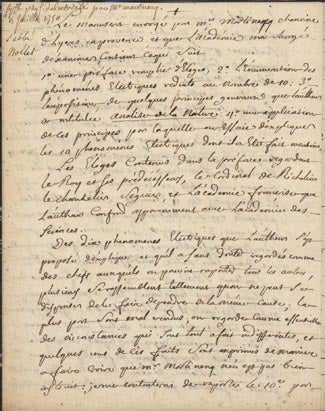
Autograph manuscript, signed. 6 1/2 pages.
Publisher Information: 1750.
Nollet, Jean-Antoine, Abbe (1700-1770). Autograph manuscript signed. Paris, July 13, 1750. 6-1/2pp., written on 2 half sheets folded to make 4 leaves (inner sheet made up of 2 quarter sheets pasted together). Creased horizontally where previously folded, negligible offsetting, otherwise fine.
Nollet trained for the priesthood, but abandoned theology for science shortly after being ordained. He became famous in the 1730s for his cours de physique, a series of scientific demonstrations performed on some 350 different instruments, constructed for the most part by himself:
"These were not mere shows, as one sees from their expanded syllabus, the famous Lecons de physique, which appeared in six volumes between 1743 and 1748 and was often reprinted. The presentations are lively, comprehensive and up-to-date, with full directions for realizing the effects under study and excellent illustrations of apparatus" (DSB).
In 1739 Nollet entered the Academy of Sciences (where he would become one of its leading members), and a few years later he was appointed to the University of Paris's first professorship of experimental physics. In 1845 he developed a theory of electrical attraction and repulsion that supposed the existence of a continuous flow of electrical matter between charged bodies. Nollet's theory at first gained wide acceptance, but met its nemesis in 1852 with the publication of the French translation of Franklin's Experiments and Observations on Electricity.
Franklin and Nollet found themselves on opposite sides of current debate about the nature of electricity, with Franklin supporting action at a distance and two qualitatively opposing types of electricity, and Nollet advocating mechanical action and a single type of electric fluid. Although Nollet's theory was eventually abandoned, the arguments between the two factions ended up strengthening Franklinian theory:
"Under prodding from Paris the Philadelphia system was progressively refined into classical electrostatics. In particular, the need to come to terms with Nollet colored the reforms of Aepinus (1759); and Nollet himself, by spreading the dualistic theory of Robert Symmer in Italy, set in train developments that culminated in the invention of the electrophorus (1775), which in turn forced the excision of the last vestiges of the traditional theories (the 'electrical atmospheres') from Franklin's system" (DSB).
The present manuscript is a lengthy analysis of a manuscript treatise on electricity submitted to the Academy of Sciences by one M. Martinenq of Hyers in Provence. Martinenq's treatise was based on the following three principles:
(1) the existence of only four elements (air, fire, water and earth);
(2) the unchangeable nature of these elements, which cannot be altered by chemical means; and
(3) the existence of affinities between like elements that would allow, for example, the "fire" in one object to communicate with the "fire" in another.
It was largely on the basis of this last principle that Martinenq proposed to provide explanations for ten electrical phenomena; however, according to Nollet's critique,
"several [of these phenomena] resemble each other so much that one cannot help assigning them to the same cause; the majority are badly expressed; the author believes certain circumstances to be essential when in fact they are immaterial, and certain of these facts are so expressed as to make one believe that Mr. Martinenq has not been well instructed in this subject."
In the course of debunking Martinenq's system, Nollet discusses electrical phenomena such as friction, the attraction between electrified bodies, the generation of sparks and noise, and brush discharge. He ended by recommending that the Academy of Sciences not publish Martinenq's treatise, since "quant aux phenomenes Èlectriques, il m'a paru que l'auteur n'etait pas suffisamment au fait de la matiere" (as for electrical phenomena, it seems to me that the author is not sufficiently grounded in the matter). Book Id: 38302Price: $7,500.00
